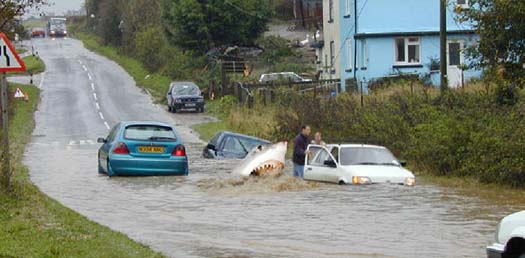
|

|
|
|
|
The picture below, snapped by German tourist Hans Grubaker visting rural France on a rainy day, depicts a most rare and horrifying sight: the attack of the elusive and extremely dangerous Flood shark. This shark, brought in from the sea when very young by storms or busses, can grow as large as 22 feet and can swallow, in a single gulp, a man, or an entire basket of bread and cheese. Though not well-publicized, mostly due to the rural areas in which the sharks grow and feed, the Flood shark has been extensively studied and documented. "Nous avons su que pendant longtemps ces requins existent. (We have known for a long time these sharks exist.)", reports Jacques Dennolier, a French marine-biologist. "Nous les avons vus et les avons étudiés, mais il est très difficile les trouver. (We have seen them and studied them, but they are very difficult to find.)" No Flood sharks have been kept alive in captivity, largely due to a need for a high degree of automobile pollution in their habitat, as well as marine-biologists' reluctance to feed the sharks baskets of bread and cheese. "Bon Dieu! (Good God!)", exclaimed Pierre Benevue, owner of Gâté Le Fromage (The Bad Cheese), "Ce juste ne serait pas exact! (It would just not be right [to feed them bread and cheese]!)." Many Flood shark attacks occur within the continental United States, mostly in the South, an area prone to routine flooding. These attacks are almost entirely unheard of, because the residents in the areas afflicted usually take matters in to their own hands. "Why, one of them thar' critters got at my cousin Zeek t' other day.", spoke a somber Jude Wilkins of Hot Coffee, Mississippi, "But I went out and got 'im." Wilkins menacingly brandished his aged double-barrel shotgun. "That critter was a good eatin'.", he added. Such situations are not uncommon. The recent rise in Flood shark attacks around the world has spurred the United Nations to form a coalition for the protection of humans from such incidents. "Nós necessitamos segurar agora esta ameaça, antes que mais mortes ocorram. (We need to handle this threat now, before more deaths occur.)", spoke Esteban de Ybarra, the Portuguese ambassador to the U.N. and coalition chairman, "Os recursos devem ser alocados. (Resources must be allocated.)" At this time, 46 of the 189 United Nations' member states have joined the coalition. In response to the U.N. coalition, PETA (People for the Ethical Treatment of Animals) has responded violently. "We will not tolerate a United Nations coalition against any animal!", shouted Peter Piltdown, a PETA spokesman, at a demonstration held on the steps of the U.N. building in New York, "The Flood shark is a rare and beautiful animal, and like all of Earth's creatures, should be respected and protected. We are prepared to take this to the absolute limit!" PETA has made good on this statement as several pie-throwing incidents have been linked to the organization since the announcement. While lauded by PETA as a beautiful animal in need of protection, Flood sharks are very, very dangerous. These animals can hide in relatively shallow flood puddles, with almost no cover, changing their size at will (though rumor has it their mass remains the same). Scientists have speculated Flood sharks, in times of drought, may make themselves so small as to nearly disappear. One report states "Flood sharks may often shrink close to the level of invisibility, then become swept up in a storm and deposited in other locations." Apparently, this natural transportation phenomenon assists in the perpetuation of the species. Flood sharks have also been seen boarding and riding busses in rural areas, always carrying baskets of bread and cheese, then disembarking near large flood puddles, but no violent occurrences have been reported from any such actions. Scientists believe bread and cheese is the key to the Flood sharks' remarkable passivity in these situations. As for French citizen Arval Benicoeur (pictured below) on this particular rainy day (Thursday, 26 July 2001), the end was grim but quick. "Ich könnte nicht meinen Augen glauben. (I could not believe my eyes.)", stated Grubaker (the German tourist who captured the attack on film), "Der Haifisch gerade erschien vom Nirgendwo und griff den armen Mann an. (The shark just appeared from nowhere and attacked the poor man [Benicoeur].)" Benicoeur, ever the good samaritan, had stopped to assist Sherriere Laroche, her car caught in the flood waters, and was explaining to Laroche the benefits of keeping her car door closed in such emergencies, when the attack came. "Il était un si bon et aimable homme. (He was such a good and kind man.)", cried Laroche after the incident. "J'avais vu qu'il à la mémoire beaucoup de fois et nous a permuté des sourires. (I had seen him at the store many times and we exchanged smiles.)", she continued before succombing to her sobs. Neither Benicoeur nor Laroche were aware of the imminent attack. Even Grubaker did not expect to capture the attack on film. "Ich ging gerade, das Photo zu machen und dann und dann.... (I just went to take the picture, and then, and then....)", explained Grubaker before also being overtaken by fits of tears. As is normal, this Flood shark attacked from a low position in the flood puddle, grabbing Benicoeur about his middle, and shaking him violently while dragging him beneath the surface. Laroche, suddenly aware something was extremely awry, backed away out of the flood puddle, and quite unconsciously to safety. Though local police and rescuers searched the area after the puddle had receeded, Benicoeur's body was not found. In reviewing this incident, scientists believe that because bread and cheese were rarely transported through the area, this Flood shark was moved to attacking humans through starvation.  |
|
Back to CrashRhinoceros.com |